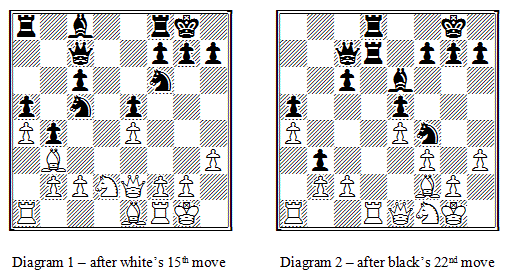
Spontaneous Chess
by David Long
On the morning of Saturday, May 28, 2005, I woke up and felt like playing chess. So, I grabbed my stuff and headed for Oak Brook to register for the three-day schedule of the Chicago Open. The first round began at noon, so I had just enough time to grab some lunch at the mall across the street before starting to play.

After the game was over, I remembered that I had to work on Tuesday morning. There was just enough time to go to the TD’s headquarters and request the last-round bye before the pairings for Round 2 went up. My opponent was 1918-rated Gilberto Luna, who was visiting from Miami. Playing black, I didn’t dig myself into a hole in the opening this time (that would come later!) but had decided on a strategy of weird king moves hoping to snag a pawn or two. 1 P-K4 P-QB3 2 P-Q4 P-Q4 3 PxP PxP 4 B-Q3 N-QB3 5 P-QB3 N-B3 6 B-KB4 Q-N3 7 Q-N3 QxQ 8 PxQ P-K3 9 N-B3 N-KR4 10 B-B7 K-Q2 11 B-K5 P-B3 12 B-N3 B-Q3 13 P-N4 N-B5 14 BxN BxB 15 P-KN3 B-Q3 16 QN-Q2 K-B2 17 P-N5 N-K2 18 0-0 B-Q2 19 P-B4 [Diagram 3] PxP 20 BxBP N-Q4 21 KR-QB1 K-N3 22 N-K4 B-K2 23 BxN PxB 24 N-B3 B-Q3 I had not considered this line when playing my king out. QB2 had to be defended, and …B-K3 was out of the question (because of 25 R-K1). Here, he can play 25 NxPch KxP 26 N-B7ch which gives me the choice between conceding a rook on the seventh rank with …BxN 27 RxB, or moving the king and relying on Tarrasch’s proposal that a rook and two bishops are approximately equal to two rooks and a knight. Computer analysis after the game showed that the former course of action was preferable because 26…K-N3 27 NxRch RxN 28 N-Q2 still presents a problem. Perhaps he wanted something a little more promising for him, because he played 25 NxPch KxP 26 N-Q2 KR-QB1 [Diagram 4] I offer to concede a pawn to 27. RxR RxR 28 RxP, but in doing so I activate my pieces (at last!) and have good chances with my better-placed king and two bishops against two knights. He keeps the pressure on with 27 N-K4 RxRch 28 RxR B-N1 29 R-B5ch K-R3 30 P-QN4 P-QN3 31 N-B7ch BxN My rook is still trapped in the corner. The two knights are dominating the two bishops here! 31…K-N2 runs into 32 N-Q6, checkmate! 32 RxB R-Q1 33 N-B3 Once again, the remainder of the game score is lost to time pressure, which is a shame because the knight-bishop ending which followed was very interesting. My bishop found itself having to stop the advance of pawns on two sides, but I was able to create a passed queen’s rook’s pawn which diverted his king just long enough to set up a defensive position. I escaped with the draw on move 57.
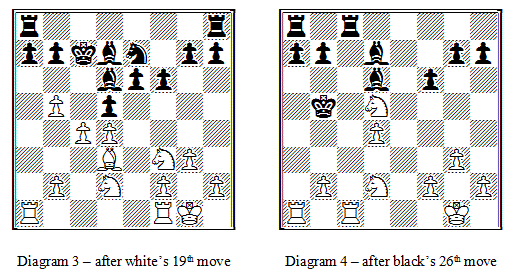
The third round, held Saturday evening, was the round where the three-day schedule merged with the four-day schedule, and the entire Under 2000 section moved up to the large tournament room on the main floor. The time limit for this round and all the remaining ones was 40/2, SD/1. My opponent in the third game was Thomas Triplett, rated 1882. I had white, and the game began as a Maroczy Sicilian variation. 1 P-K4 P-QB4 2 P-QB4 N-QB3 3 N-KB3 P-KN3 4 P-Q4 PxP 5 NxP B-N2 6 B-K3 N-B3 7 N-QB3 0-0 8 P-KR3 NxN 9 BxN P-Q3 10 B-K2 B-K3 11 0-0 Q-R4 12 Q-N3 Q-B2 13 QR-B1 Q-Q2 (we both missed 13…NxP!) 14 KR-Q1 KR-QB1 Black is just starting to turn up the pressure when I decided to rip the position open. 15 P-K5 N-K1 16 B-B3 RxP 17 QxP QxQ 18 BxQ R-N1 19 B-Q5 BxB 20 NxB RxR 21 RxR BxP 22 BxB PxB 23 NxPch K-B1 24 R-B8 RxR 25 NxR P-QR3 [Diagram 5] Phew! The board was demilitarized very quickly. Computer analysis found that Black could go pawn-munching: 24…RxP 25 N-Q5 R-N2 (else he loses the knight), but 26 R-R8 P-B4 27 N-B6 R-K2 28 NxN RxN 29 RxP recovers the pawn and gives white somewhat better chances. 26 K-B1 P-B3 27 K-K2 K-B2 28 K-Q3 K-K3 29 K-B4 K-Q2 I had almost expected 29…N-Q3+ but he wanted to keep the knights on the board. 30 N-N6ch K-B3 31 N-R4 P-B4 32 P-QN4 N-Q3ch 33 K-B3 N-K5 34 P-B3 N-Q3 35 N-B5 P-K5? Something else unexpected. I thought he was going to play …P-QR4, after which I would have to spend time considering whether to play N-Q3 or N-K6. 36 PxP PxP 37 NxRP P-K6 38 N-B5 P-K7 39 N-Q3 P-N4 40 P-QR4 N-K5 41 K-B4 N-B7 42 N-K1 N-Q8 43 P-N5ch K-N3 44 K-N4 P-R4 45 P-QR4ch K-N2 46 K-B5 P-R5 47 P-R6ch K-N1 48 P-N6 N-K6 49 K-B6 P-N5 [Diagram 6] Given enough time, black could force a promotion with …NxP. However, my pawns are sufficiently far advanced that I could checkmate him before he could do anything about it. For example: 49…NxP 50 P-R7ch K-R1 51 K-B7 NxN 52 P-N7ch KxRP 53 P-N8=Qch K-R3 54 Q-N6, checkmate. 50 P-R7ch K-R1 51 PxP N-B5 52 P-N7ch KxRP Eliminating any possibility of stalemate. 53 K-B7, black resigns.
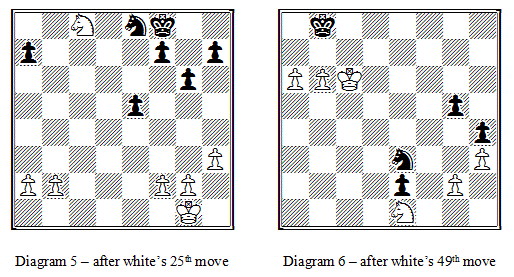
With Sunday came Round 4. I had white again, against 1960-rated Azmat Hussain. A mistake of mine in the opening went unpunished. Still, I found myself behind in development. 1 P-K4 P-Q3 2 P-Q4 N-KB3 3 N-QB3 P-KN3 4 P-B4 B-N2 5 B-Q3 B-N5 6 N-B3 N-B3 7 P-K5?! PxP (7…BxN!) 8 BPxP N-Q4 9 B-K2 Q-Q2 10 0-0 0-0 11 N-K4 QR-Q1 12 P-B3 Q-B1 I thought of playing Q-N3, but I felt like that would be barking up the wrong tree since it looks like the fighting will take place on the kingside. Instead, I tried 13 Q-K1 B-B4 14 Q-R4 P-KR4 [Diagram 7] Playing 14 N-N3 would only have blocked the diagonal I intended to use to develop my queen. Now, with his last move, I can start thinking about possibly sacrificing on KR5, if the position allows it. 15 N-N3 P-B3 16 PxP RxP? I think this move does him nothing but harm. Suddenly he has a lot of kingside weaknesses, I develop my remaining pieces swiftly, and win a little material in the process. 17 B-N5 R-B2 18 NxB RxN 19 B-Q3 QR-B1 20 BxR RxB 21 QR-K1 Q-KB1 22 Q-K4 N-B3 23 Q-K6ch K-R2 24 B-Q2 N-KN5 25 N-N5ch K-R3 26 N-B7ch K-R2 27 RxR PxR 28 N-N5ch K-R1 29 Q-N6 N-B3 [Diagram 8] Here, 30 R-K6 almost puts him away, but after …K-N1 31 RxN QxR there’s no mate. 30 QxBP Q-KN1 31 Q-K6 Q-K1 32 Q-B7 Q-Q2 33 N-K6 N-K1 34 NxB NxN 35 B-R6 N-B4 36 R-K6 N/3xP Trying to bring his pieces into the game, but it’s too late. 37 B-N7ch NxB 38 R-KR6, checkmate.
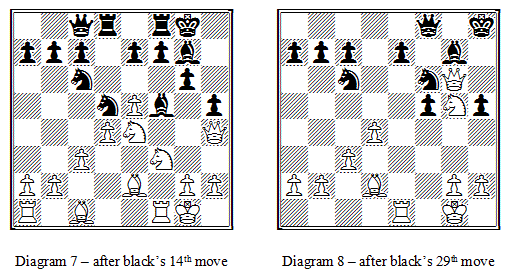
The two-day schedule merged into the main tournament at this point, and when I checked the updated wall charts, I saw the Under 2000 section had 101 players. (A few of them were re-entries.) When the pairings went up for the fifth round, I got a pleasant surprise: my third white in a row. My opponent was 14-year-old Warren Harper, from Houston. He was rated 1866. He played an odd variation of the Winawer French, a variation which I had seen occasionally playing on FICS, but not yet in a tournament. During the middlegame, I found myself with an air-conditioned king, undefended pieces, and a pawn structure in shambles, but there were enough defensive resources to end the threat of checkmate, and start making some threats of my own. Of all the games I played in the tournament, this one was the most enjoyable. The game began 1 P-K4 P-K3 2 P-Q4 P-Q4 3 N-QB3 B-N5 4 P-K4 P-QB4 5 P-QR3 B-R4!? 6 P-QN4 PxQP 7 QxP B-B2 8 N-B3 N-QB3 9 Q-N4 K-B1 10 B-KB4 P-B3 11 PxP KNxP 12 BxB QxB 13 Q-N3 P-K4 [Diagram 9] Here, 14…NxP is a nasty threat, with the twin threats of …QxNch and …NxPch. Right now, his central pawns are adequately defended. If I can just find a way to keep the pressure on them, and maybe end some of his threats as well, I might have a playable position. I thought for almost 40 minutes and came up with 14 0-0-0!? My king is only marginally safer here than it was in the center, but the move ends the possibility of …NxNP-xBPch, in fact …NxP allows 15 QxKP holding everything. He also needs to do something about his queen’s pawn, which is now attacked. He played …B-B4. Now, the pawn is a lot less appetizing because 15 NxQP NxN 16 RxN NxP runs into some hard-to-stop mate threats. I can take advantage of the fact that his queen is temporarily undefended to complete my development and end the mate threats. 15 B-Q3 BxB 16 RxB R-B1 17 R-K1 P-K5 It looks like the pawn fork works now, but I have an ace up my sleeve in the form of 18 QxQ RxQ 19 N-KN5 PxR 20 N-K6ch K-B2 21 NxR R-QB1 22 N/7-N5 [Diagram 10] I opted not to play 22 N/7xP because …NxN 23 NxN N-Q5, while not obviously winning by force, still looks unpleasant. Here begins the second phase of defense, which my opponent referred to during post-game analysis as the “rickety knight chain”. …K-N3 23 N-Q6 R-B2 24 R-K3 PxP 25 R-N3ch K-R4 26 P-B4 N-Q5 [Diagram 11] Now, suddenly it is the black king in danger of being checkmated. Black’s last move was to prevent 27 R-N5ch and 28 N-B5, checkmate. 27 N/6-N5 NxN 28 NxN R-B5 The only move which keeps the rook on the queen’s bishop file and, since it threatens the white pawn on KB4, ends the mate threat. 29 R-N5ch K-R5 Giving black a chance to fall asleep and play 29…K-R3, after which 30 N-Q6, with twin mate threats, costs him his rook – or his king! 30…RxBP 31 N-B7 is still checkmate. Forcing the king to KR5 also tactically protects the pawn on KB4 for the moment. 30 RxNP N-K5 31 RxRPch K-N5 32 R-QB7 N-B7 33 RxR N-Q6ch Black’s knight arrives on this square a moment too late. 34 KxP PxR 35 P-N3 P-R3 36 N-Q4 K-R6 37 K-B3 P-N4 [Diagram 12] The king move has another point: it will be impossible for it to be checked by the knight from black's KB6 in one move. 38 P-B5 KxRP 39 P-B6 N-K4 40 N-B3ch, Black resigns. If the king were still on QB2, this trick would not work because after 40…NxN 41 P-B7 N-Q5ch gets one more move to get to K3 and stop the pawn.
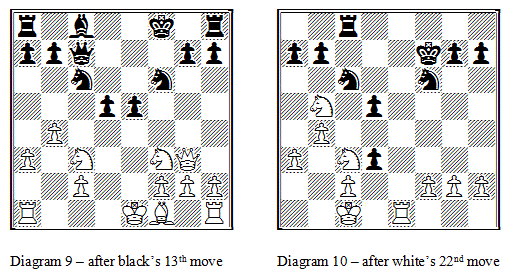
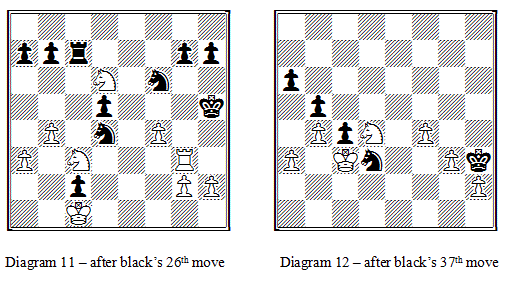
Round 6, held Monday morning, put me across the board from Garrett Smith, rated 1962. I had black. Once again, I found myself on the short side of the opening, with a weak pawn. 1 P-K4 P-Q4 2 PxP QxP 3 N-QB3 Q-QR4 4 P-Q4 N-QB3?! 5 P-Q5 N-K4 6 Q-Q4 N-Q2 7 B-Q2 Q-B4 8 QxQ NxQ 9 B-KB4 P-QB3 10 0-0-0 N-B3 11 PxP PxP 12 B-K2 P-K3 13 B-B3 B-N2 14 KN-K2 B-K2 [Diagram 13] He piled up on the pawn with 15 N-Q4 N-Q4 16 NcN BPxN 17 N-N5 0-0 18 P-B4 KR-Q1 19 PxP BxP 20 BxB PxB 21 KR-K1 N-K3 I thought he could win a pawn with 21 N-B7 QR-B1 22 K-N1 P-Q5 23 N-N5, but instead he brings his last piece into action. 22 B-K3 P-QR3 23 N-Q4 QR-B1ch 24 K-N1 B-B3 25 NxN PxN He helped me out there. The weak pawn is now a protected passed pawn! 26 B-Q4 K-B2 27 P-QN3 R-B3 28 BxB PxB Bringing another pawn toward the center, with the potential for two connected passed pawns, looked like it offered more winning chances than taking with the king. 29 R-QB1 KR-QB1 30 RxR RxR 31 R-QB1 RxRch 32 KxR K-K2 [Diagram 14] I liked my chances in the king and pawn ending better than keeping the rooks on the board, especially since his rook would get active. I have a passed pawn, but he has a potential passed pawn on the queenside. I have to prevent him from making a passed pawn on the kingside at any and all costs. 33 K-Q2 K-Q3 34 P-B4 P-KR4 35 P-B5? P-K4 He tries to break up my pawn formation, but fails and gives me the two connected passers instead. He may still try to get a passer on the kingside, but my pawns are too fast. 36 K-Q3 K-B4 37 P-QR3 P-QR4 38 P-N3 P-K5ch 39 K-K3 P-R4 Prying open an entrance for my king. 40 P-N4ch K-B5 41 P-R3 P-Q5ch 42 K-Q2 If 42 KxKP P-Q6 43 K-K3 K-B6 and the passed pawn wins. …P-K6ch 43 K-Q1 P-Q6 44 P-N4 PxP 45 PxP K-B6 46 P-N5 P-K7ch 47 K-K1 K-B7 48 K-B2 P-Q7, White resigns.
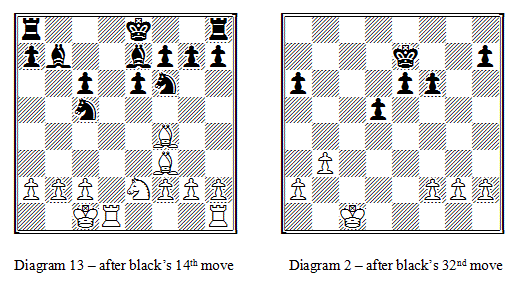
After my last round bye, my score was 6 points out of 7. An inspection of the wall charts showed that there were three other players in my section with 5 points after 6 rounds. Two of them would have to play each other, and the third would play someone with 4½. I had been planning to leave immediately after Round 6, so I could get to sleep early and get up for work Tuesday morning, but since I found myself in a position to do no worse than a three-way tie for first place, I decided to stick around and watch the last round. There were two games which could affect the number of people with 6 points, which I watched for several hours, until finally, they both broke the way I had hoped for. Two of the players with 5 points had drawn each other, and the other one had lost, leaving me in clear first place in the section.
I didn’t get home until 3:30 a.m., leaving me with only a very short time to sleep before the work day started at 7:00. But, it was worth it for an enjoyable weekend and some great chess.